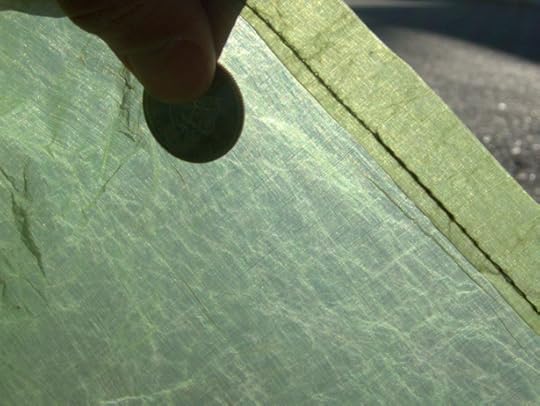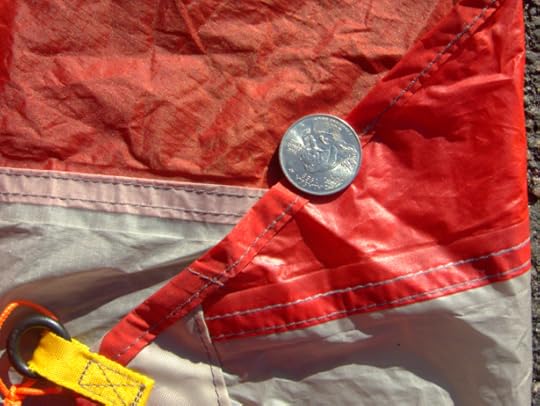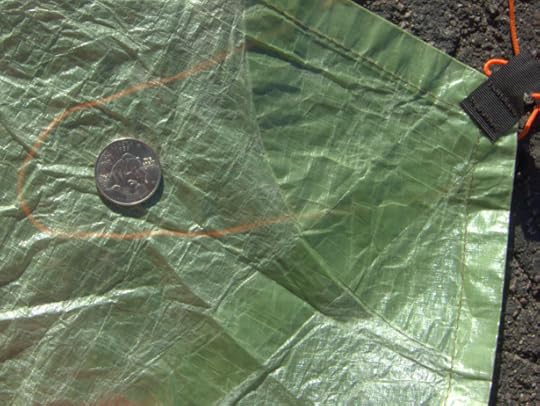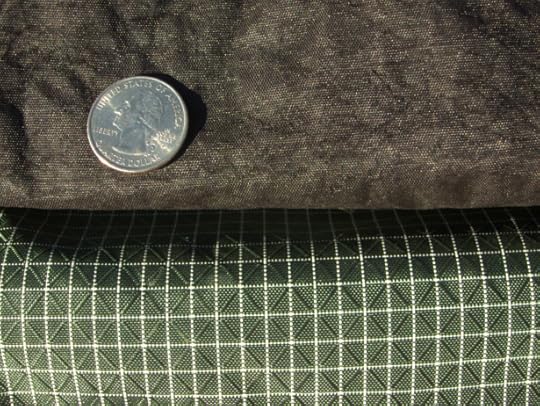Reader question: Are Cuben Fiber shelters & backpacks worth the cost?

A question from reader Patrick H.:
I plan to buy a new tent and backpack, as part of a larger effort to reduce the weight of my gear. I’m attracted to the weight of Cuben Fiber, but I’m concerned about its durability relative to sil-nylon or Robic. Is it worth the premium price?
Most backpackers who look beyond REI while researching gear have probably learned of Cuben Fiber, either in a standalone conversation or as a fabric option for shelters, backpacks, and accessories made by cottage brands like Hammock Gear, Katabatic Gear, Mountain Laurel Designs and others.
Cuben stands out, partly because equipment made with it is exorbitantly expensive relative to comparable products made of more conventional fabrics. A few examples:
In Cuben, the MLD Cricket Tarp costs $335. In a premium sil-nylon, it’s $185.
The Hyperlite Mountain Gear Southwest 3400 costs $330. The ULA Ohm 2.0 costs $210.
A 5.6L Cuben stuff sack from ZPacks costs $20. A 5L sil-nylon stuff sack from Granite Gear costs $11.
These price tags beg the question: Is Cuben Fiber worth the cost?
What is Cuben Fiber?
Cuben Fiber, also known as Dyneema Composite Fabric (DCF), is a grid of Dyneema fiber — which is the strongest fiber in the world, at 15 times the strength of steel per weight — embedded in flexible polyester film. Imagine a painters plastic-type material that is remarkably waterproof, tear-resistant, and lightweight.
The most common versions of Cuben weigh 0.5 oz/yd2 and 0.75 oz/yd2.

Cuben Fiber is a grid of Dyneema fibers embedded in a translucent and flexible polyester film. For its weight, it is exceptionally strong and waterproof.
Cuben can also be laminated to other fabrics, like a 50-denier polyester, to improve resistance to abrasion and puncture. These laminates weigh more, in the range of 3.0 to 5.0 oz/yd2, depending on the Cuben variety and the laminating fabric. ZPacks and Hyperlite Mountain Gear are both well known for their backpacks made of Cuben laminates.

To improve its resistance to abrasion and punctures, Cuben (the clear shiny fabric) can be laminated to another fabric, such as a 150d polyester (the black fabric). The combination makes a worthy pack fabric. The Cuben is kept on the inside of the pack, where it is more protected.
Shelter fabrics
Conventional fabrics
Backpacking shelters are typically made of woven nylon or polyester. If the fabric must be waterproof — such as the case with a tent fly or floor — it is coated with polyurethane (PU), polyethelete (PE), or silicone (sil).
All things being equal, silicone results in the strongest and most waterproof fabric. However, pure sil-nylons cannot be seam-taped and do not meet fire-resistant standards for critical US markets like California and New York. So wholesalers like Sierra Designs, MSR, and REI use fabrics that are treated with silicone on one side and with PU or PE on the other.
I think that we will see fully seam-taped and fire-resistant sil/sil nylon available within a few years. But the technology is not yet commercial.

A conventional coated nylon that is treated with sil on one side (upper left half) and with PU or PE on the other (lower right half) so that it can be seam-taped and fire-resistant.
Today’s best coated woven fabrics weigh 1.0 to 1.5 oz/yd2 and have been rated up to 4,000 mm of hydrostatic head, several times in excess of “rainproof” standards. If the fabric performance is undisclosed — such as in the case of Big Agnes tent fabrics — you should assume that it is less.
In the case of hydrostatic head, more is better. A more waterproof fabric will withstand greater forces and will have a longer service life.
The quality of coated wovens is continually improving. I’m certain that the shelter fabrics I used on my longest trips are not as good as what I use and see today, while guiding trips and designing shelters with Sierra Designs.
Among active backpackers, coated wovens may have a trust issue. A high quality coated woven makes an excellent shelter fabric, but one bad experience with a low quality version (e.g. cheap or poor quality control) may create nervousness about the whole fabric category. Personally, I have never experienced “misting,” but I have had to replace multiple shelters because they were no longer reliably waterproof — they absorbed too much water, and in some cases would visually leak.
Cuben Fiber
As a shelter fabric, Cuben is very attractive — if you can afford it. A shelter made of Cuben will be:
Lighter by 30 to 50 percent, depending on the exact fabrics being compared and on the amount of non-fabric parts, e.g. zippers, buckles, struts.
As waterproof as the best coated nylons, with hydrostatic head ratings of 3,500+ mm.
The performance of Cuben will degrade over time due to use, UV exposure, repeated folding, and wet storage. But the lifespan is still excellent. Ron Bell at MLD estimates the functional lifespan of his shelters made with .75 oz/yd2 at around 250 “thru-hiker nights,” which assumes intense use and occasional wet storage. This is comparable to or in excess of standard coated nylons, which Ron puts at 300 to 500 nights depending on the quality.

Cuben is an exceptional shelter fabric: it is ultralight and extremely waterproof.
Besides cost, weight, waterproofness, and tear strength, there are a few other noteworthy qualities of Cuben. First, it does not “stuff” small. The material is stiff relative to coated wovens, so it needs to be folded for it to pack away small.
Second, Cuben does not stretch. This results in a less forgiving pitch — the tension and anchor points must be perfect — but the shelter will stay taut until the morning. Sil/sil nylon is especially stretchy, and a pre-bed and sometimes middle-of-the-night adjustment is necessary, especially in wet or humid conditions. Obviously, this could get annoying.
Third, the surface of Cuben is less slick than coated wovens, so more snow tends to stick to it. I’ve had multiple Cuben shelters on my winter guided trips with no issues; the coated nylon shelters nearby have fared better, but not dramatically so.
I have had mixed experiences (and have heard mixed reports) about the water absorption of Cuben versus coated wovens. With use, I think you should expect both fabric types to absorb more water than when new.
Is Cuben worth it?
Without knowing your budget or your expected use, I can’t tell you if a shelter made of Cuben is worth the premium price. But hopefully you now have the information necessary to decide.
If you need some help deciding, leave a comment below with an explanation of your situation.
Pack fabrics
The weight and performance of a shelter, especially common designs like A-frame tarps, is largely a function of its fabric.
This is not the case with backpacks. I can think of at least a handful of considerations that I prioritize above the pack fabric, including:
Fit/comfort,
Suspension/load-carrying ability,
Pockets,
External utility and compression, and
Volume.
Conventional fabrics
Premium conventional pack fabrics may be branded as Cordura, Dyneema, Robic, and X-Pac. They are all woven nylons, perhaps with a reinforcing gridstop of an exceptionally tough or thick fiber. They can be coated with PU or sil to improve resistance to water, abrasion, and tearing.
For long-term abuse, I would avoid any fabric less than 100 denier.
As a thru-hiker I put serious miles on a handful of packs. For example, I used one GoLite Jam for the length of my 7-month 6,875-mile Great Western Loop trip. And I used the ULA Epic for about two-thirds of my 6-month 4,700-mile Alaska-Yukon Expedition. The packs were made of 210d Dyneema and 210d Robic, respectively. These are high quality fabrics, but reasonably priced and widely available.

Top: A Cuben laminate with 150d black face polyester face fabric. Bottom: The 210d Robic nylon that is standard on ULA packs.
Cuben Fiber
On its own, Cuben Fiber is an inferior pack fabric, unless you are okay with:
Disposable gear, or,
Babying your backpack.
Why? Because Cuben has poor resistance to abrasion and puncture. For its weight, it’s pretty good, but for my uses I would never buy a pack made only of Cuben, even the heaviest version of it — it would get trashed by a few bushwhacks or rough bumps against granite.
Cuben laminates — whereby Cuben is glued to another fabric, like a 50d polyester — are another story. Their performance is more comparable to the premium woven nylons mentioned earlier, and some would argue that they are even better. The supposed value-added:
Weight-savings,
Greater tear-strength, and,
Waterproofness.
But I think this argumentation is dubious:
1. A pack made of a Cuben laminate will be marginally lighter, by perhaps 5 percent. The reason: the pack fabric constitutes just a small fraction of the overall pack weight. Most of the weight of a pack is its suspension, hipbelt, shoulder straps, and buckles and straps.
2. Based on past performance, standard woven nylons have proven to have sufficient durability for hard, multi-month trips.
3. With extended use, Cuben laminate packs will not remain waterproof. So, as with a pack made of woven nylon, you will need to waterproof your gear. I recommend using a 20-gallon trash compactor bag as a pack liner.
Is Cuben worth it?
If you find a Cuben laminate pack that fits you perfectly and that has your exact wish list of features, go for it.
But I would strongly discourage limiting your search to packs only made of Cuben. They are not functionally lighter or tougher than packs made of conventional woven nylons, and you will pay $50-100 more for it.
Your turn: Do you think that Cuben Fiber is worth the price? Leave a comment.
Disclosure. This website is supported mostly through affiliate marketing, whereby for referral traffic I receive a small commission from select vendors, at no cost to the reader. This post contains affiliate links. Thanks for your support.
The post Reader question: Are Cuben Fiber shelters & backpacks worth the cost? appeared first on Andrew Skurka.



